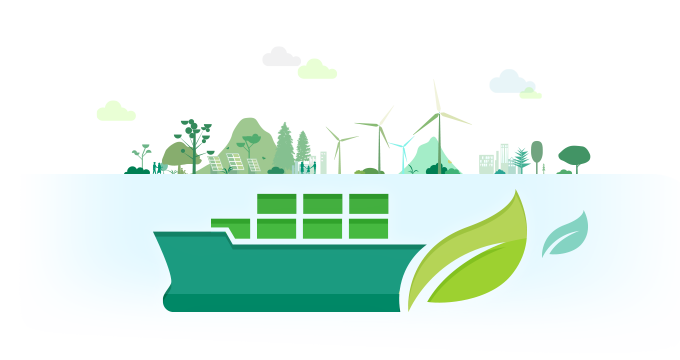

Green Sailing Service?
By using HMM’s Green Sailing Service, proactively and directly reduce your CO2e footprint and report enhanced Scope 3 emissions for your stakeholders.Now Available!
- Just suggest a required amount of GHG R1) R1) GHG (Greenhouse Gases) : CO2, CH4, N2O (In terms of Well to Wake) you wish to reduce for your Scope 3 reporting Just suggest a required amount of GHG R1) R1) GHG (Greenhouse Gases) : CO2, CH4, N2O (In terms of Well to Wake) you wish to reduce for your Scope 3 reporting
- Receive a quote at the market competitive price
- Be assured of the amount of GHG reduced along with sustainable alternative fuels sourced from certified supply chains
Sustainable biofuel used for carbon insetting R2) R2) Carbon insetting directly reduces carbon emissions where they are actually emitted during the business activities, whereas carbon offsetting reduces emissions outside the business realm by purchasing carbon credits from a project a company do not own or operate.
Sustainable biofuel used for carbon insetting R2) R2) Carbon insetting directly reduces carbon emissions where they are actually emitted during the business activities, whereas carbon offsetting reduces emissions outside the business realm by purchasing carbon credits from a project a company do not own or operate.
- LNG Available from Jan 2025, Green Methanol available from April 2025
Mass Balance concept is used
- CO2eq emission reduction
- CO2eq emission




- Regardless of vessel type or deployed service of which actual customer’s cargo is on board
Provides a Green Sailing Service Declaration
- Contains amount of greenhouse gases that customer reduced by using Green Sailing Service
- Available for reporting enhanced Scope 3 GHG emissions of customers’ supply chain
- The methodology and calculation of Green Sailing Service is advised by PwC Korea in 2023
Carbon Insetting Procedure
HMM buys Sustainable biofuel*
*either low carbon LNG or methanol after DF vessel delivery-
1
COQ(Certificate of Quality)
Fuel specification -
2
POS(Proof of Sustainability)
Specification for the FAME -
3
BDS(Bunker Delivery Statement)
GHG reductions of the delivered volume
HMM reduces Scope 1 emissions
By sailing with low carbon fuelfossil-based fuel with biofuel for the voyage. *2nd generation biofuel to be used
Customer buys GHG Reduction
Regardless of the cargo’s port of origin or destination, any cargoesin terms of Mass Balance concept
Customer reduces Scope 3 emissions
Total GHG reduction within BDS will be allocated to the customer.FAQ
-
What is carbon insetting?While a carbon offset works by purchasing certificates or funding a carbon reduction project at external sector,
Carbon insetting directly reduces carbon emissions in the sector where they are actually emitted during their business (transportation). -
What are the benefits of Green Sailing?Due to mass balance concept, customers can reduce their Scope 3 GHG emissions regardless of the transport service of which actual customer’s cargo is onboard. In other words, no physical connection to the ship is required and customers still can claim to benefit of lower emissions.
HMM will offer the best solution for our customers subject to the availability and cost competitiveness of alternative fuels. -
When and how can I use Green Sailing?Customers can contact to P.I.C. for usage / quotes / inquiries / more details of Green Sailing Service.
Contact point : Green Sailing / green_sailing@hmm21.com -
What kind of document is provided?HMM will provide a 'Green Sailing Service Declaration' that contains amount of GHG reduction and the corresponding amount of sustainable alternative fuels used. Also, on customer's request, copies of relevant documents may be provided to customers. (Bunker Delivery Note, Proof of Sustainability or equivalent documents provided by bunker suppliers)
-
Is Green Sailing Service verified?The methodology for Green Sailing Service is advised by PwC Korea in Sep 2023.
-
What process do I expect?Once customer's requirement(=GHG reduction) is received, HMM will make a feasibility study and commercial offer accordingly. To ensure reduction of GHG compared to BAU (Business as usual) required amount of sustainable alternative fuels, GHG reduction effect, terms and project plan will be provided
-
When is the Declaration provided?When carbon insetting reaches customer's target value HMM issues the declaration to allocate the total GHG reduction for customers scope 3 based on certified documents. If required by customers, HMM may issue the declaration on a quarterly basis or annual basis.
-
Is Green Sailing Service expensive?The costs for Green Sailing depends on your good company’s reduction targets.
-
What alternative fuels does HMM use?HMM currently uses bio-fuel on designated vessels to reduce GHG emissions in terms of Well to Wake(WTW).
The alternative fuel ships will be introduced in coming years (LNG DF from Jan 2025 and Methanol DF from Apr 2025) -
What kind of bio-fuels are used?Bio-fuels used for Green Sailing are 2nd generation biofuels sourced from sustainable supply chains that comply with EU RED III (Renewable Energy Directive). 2nd generation biofuels are fuels that can be manufactured from various types of non-food based biomass. (e.g. forestry residues, agricultural residues, etc)
-
How much GHG reduction can biofuel do?On a life-cycle basis, B30 (HFO 70% + mix of biofuel 30%) for instance, has a lower CO2e footprint and emits 22-25% less compared to conventional fuel.